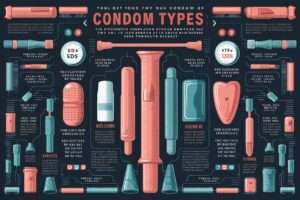Condoms and STDs: Understanding Protection and Limitations
When it comes to sexual health, condoms are often touted as a go-to method for preventing sexually transmitted diseases (STDs). While they’re undoubtedly effective in many cases, it’s crucial to understand that condoms aren’t a foolproof solution for all STDs.
In this comprehensive guide, we’ll explore which STDs condoms can effectively prevent, which ones they might not, and what you can do to protect yourself better.

Table of Contents
ToggleThe Effectiveness of Condoms in STD Prevention
Before diving into specific STDs, let’s clarify how condoms work to prevent infections:
1. Barrier Method: Condoms create a physical barrier that prevents direct contact between genitals and bodily fluids, which is how many STDs are transmitted.
2. Material Matters: Most condoms are made of latex, polyurethane, or polyisoprene, materials that viruses and bacteria can’t pass through when the condom is intact.
3. Proper Use: The effectiveness of condoms largely depends on correct and consistent use. According to the Centers for Disease Control and Prevention (CDC), when used correctly, condoms are highly effective in preventing the transmission of HIV and reducing the risk of many other STDs.

STDs That Condoms Effectively Prevent
When used correctly and consistently, condoms are highly effective at preventing the following STDs:
1. HIV/AIDS: Condoms are extremely effective at preventing the transmission of HIV. The CDC reports that consistent and correct use of condoms reduces the risk of HIV transmission by about 99% during sexual intercourse.
2. Chlamydia: Proper condom use significantly reduces the risk of chlamydia transmission.
3. Gonorrhea: Condoms are highly effective in preventing the spread of gonorrhea.
4. Trichomoniasis: Consistent condom use can greatly reduce the risk of trichomoniasis transmission.
5. Hepatitis B: While vaccination is the best protection against Hepatitis B, condoms can also help prevent its spread during sexual contact.

STDs That Condoms May Not Fully Prevent
While condoms are a crucial tool in STD prevention, they may not provide complete protection against all STDs, particularly those spread through skin-to-skin contact. Here are some STDs that condoms may not fully prevent:
1. Human Papillomavirus (HPV)
HPV is the most common sexually transmitted infection. Condoms may not fully protect against HPV because:
– HPV can infect areas not covered by a condom, such as the scrotum or vulva.
– The virus can spread through skin-to-skin contact, even without penetration.
However, consistent condom use can still reduce the risk of HPV transmission. The HPV vaccine is the most effective prevention method, often recommended for both males and females.
2. Herpes Simplex Virus (HSV)
Herpes can be transmitted through skin-to-skin contact with infected areas, which may not be covered by a condom. While condoms can reduce the risk of herpes transmission, they don’t eliminate it entirely because:
– Herpes sores can occur on areas not covered by condoms.
– The virus can be shed from skin without visible sores.
Using condoms consistently, along with antiviral medications if prescribed, can help reduce the risk of herpes transmission.
3. Syphilis
While condoms can help prevent syphilis transmission during vaginal, anal, or oral sex, they may not provide complete protection because:
– Syphilis sores (chancres) can occur in areas not covered by condoms, such as the mouth or anus.
– The bacteria can spread through direct contact with a sore during any sexual activity.
Regular testing and treatment are crucial for preventing the spread of syphilis.
4. Molluscum Contagiosum
This viral skin infection can spread through sexual contact. Condoms may not fully prevent transmission because:
– The virus can infect any area of skin, not just the genitals.
– It spreads through skin-to-skin contact, which can occur during sexual activity even with condom use.
5. Pubic Lice (Crabs)
Condoms don’t protect against pubic lice because:
– These tiny insects live in the pubic hair area, which isn’t covered by condoms.
– They can spread through close body contact or sharing contaminated items like clothing or bedding.

Enhancing Protection: Beyond Condoms
While condoms are an essential tool for STD prevention, a comprehensive approach to sexual health includes:
1. Regular Testing: Get tested regularly for STDs, especially if you have new or multiple partners.
2. Open Communication: Discuss sexual health and STD status with your partner(s) before engaging in sexual activity.
3. Vaccinations: Get vaccinated against preventable STDs like HPV and Hepatitis B.
4. Abstinence or Monogamy: The surest way to avoid STDs is to abstain from sexual contact or be in a long-term, mutually monogamous relationship with an uninfected partner.
5. Dental Dams: Use dental dams for oral sex to reduce the risk of STD transmission.
6. Pre-Exposure Prophylaxis (PrEP): Consider PrEP if you’re at high risk for HIV.
7. Education: Stay informed about STDs, their symptoms, and prevention methods.
Conclusion
While condoms are a vital tool in preventing many STDs, they’re not a guarantee against all infections. Understanding their limitations and combining condom use with other preventive measures is key to maintaining optimal sexual health.
Remember, regular testing, open communication with partners, and staying informed are all crucial components of a comprehensive sexual health strategy.
Reference to External Sources:
[1] https://www.cdc.gov/condomeffectiveness/index.html
[2] https://www.who.int/news-room/fact-sheets/detail/sexually-transmitted-infections-(stis)
[3] https://www.plannedparenthood.org/learn/stds-hiv-safer-sex/safer-sex
[4] https://www.nhs.uk/conditions/contraception/male-condoms/


